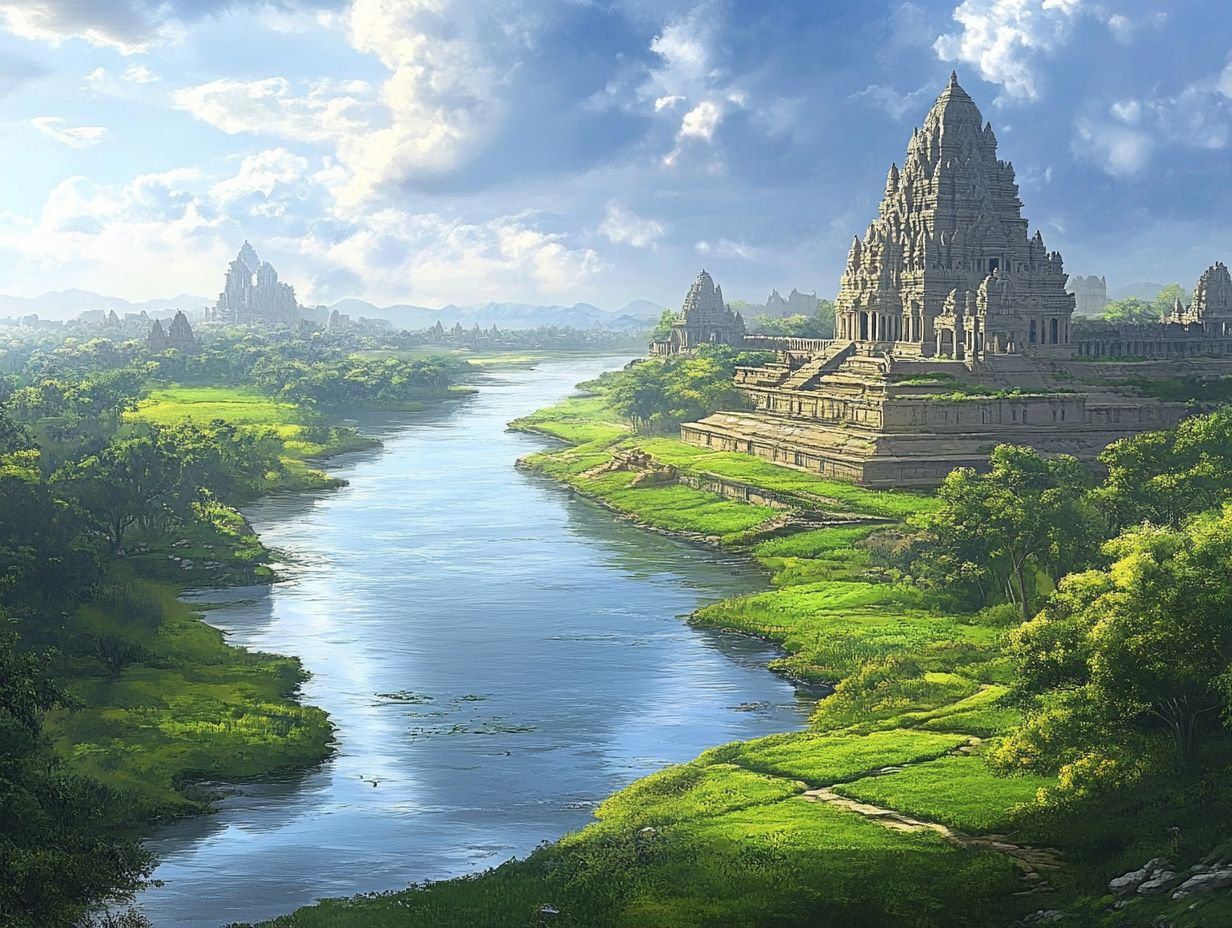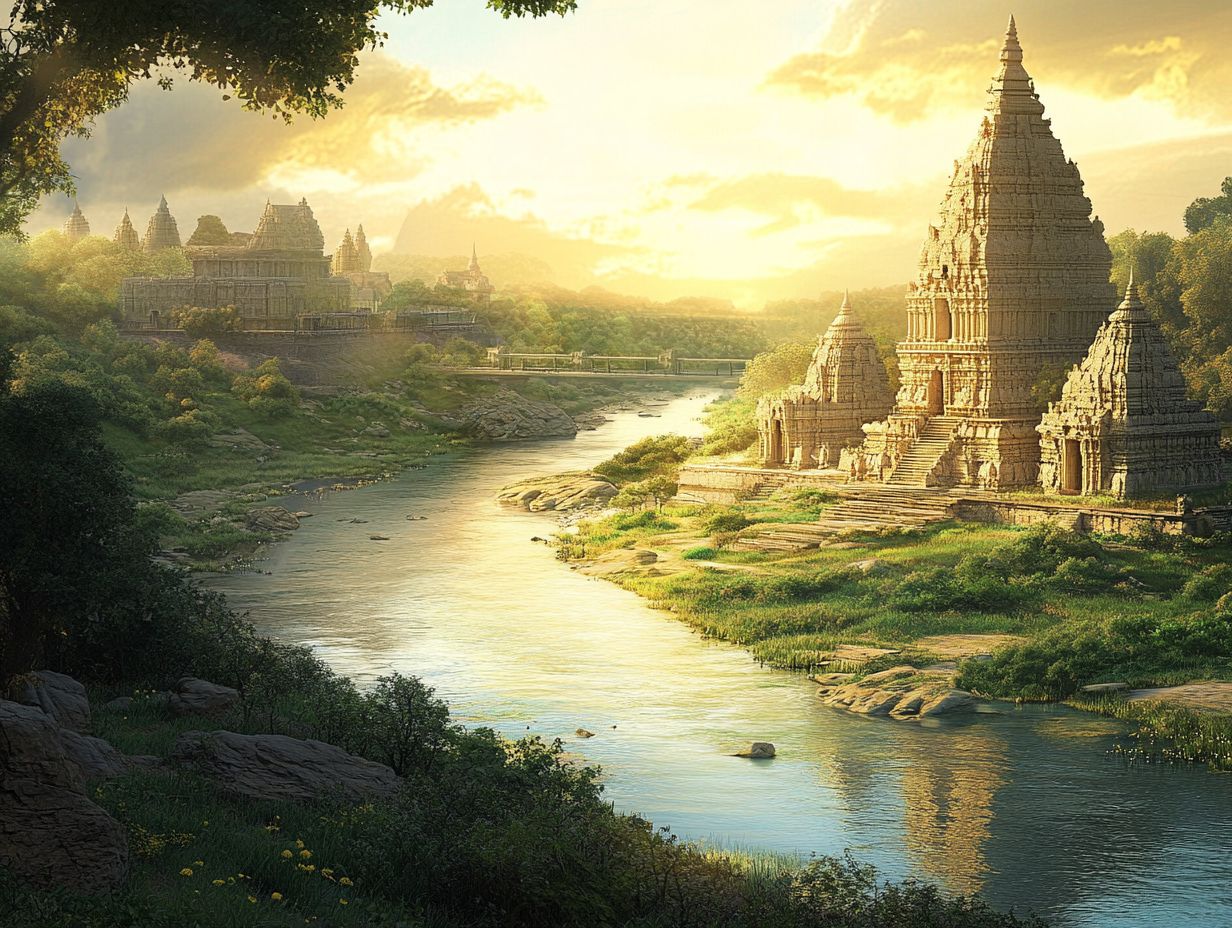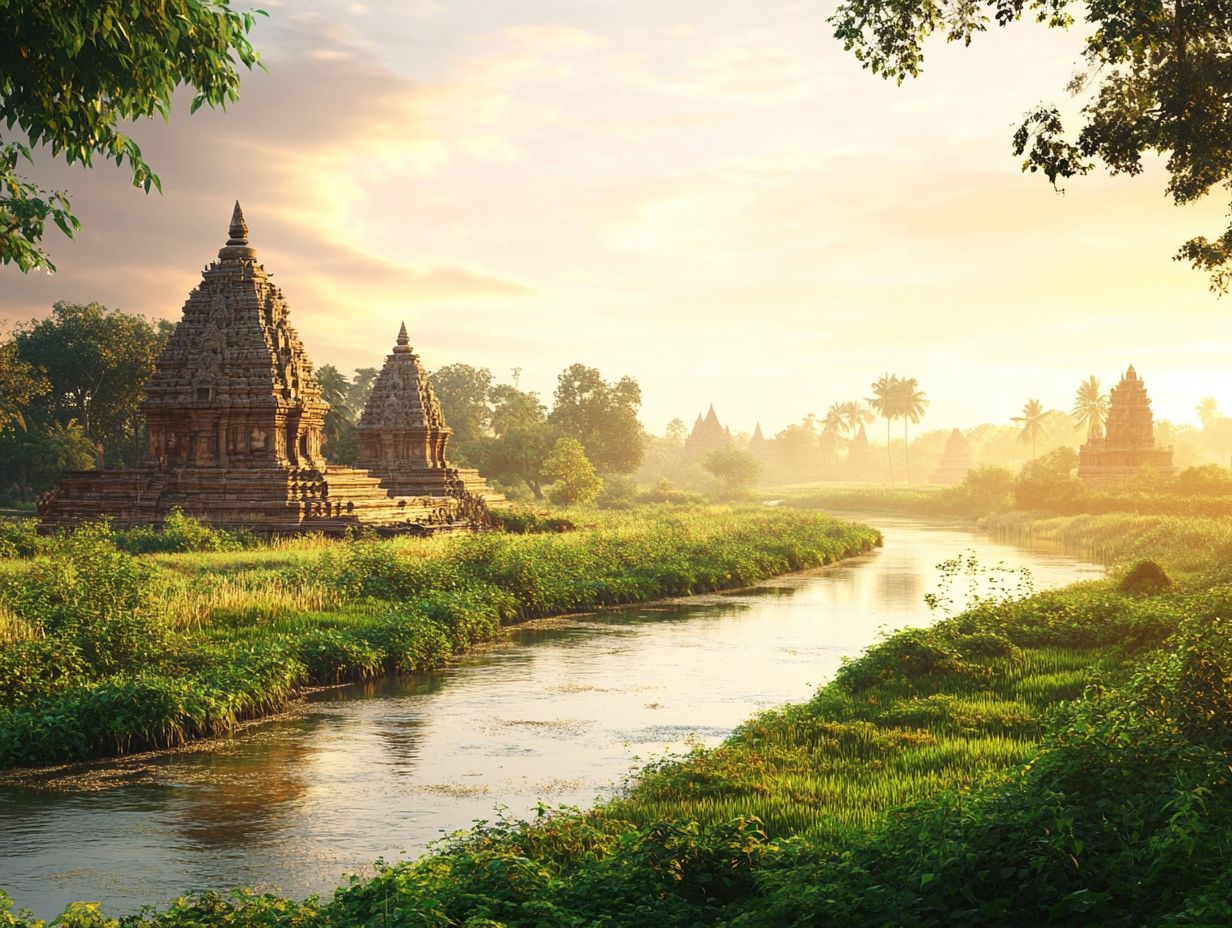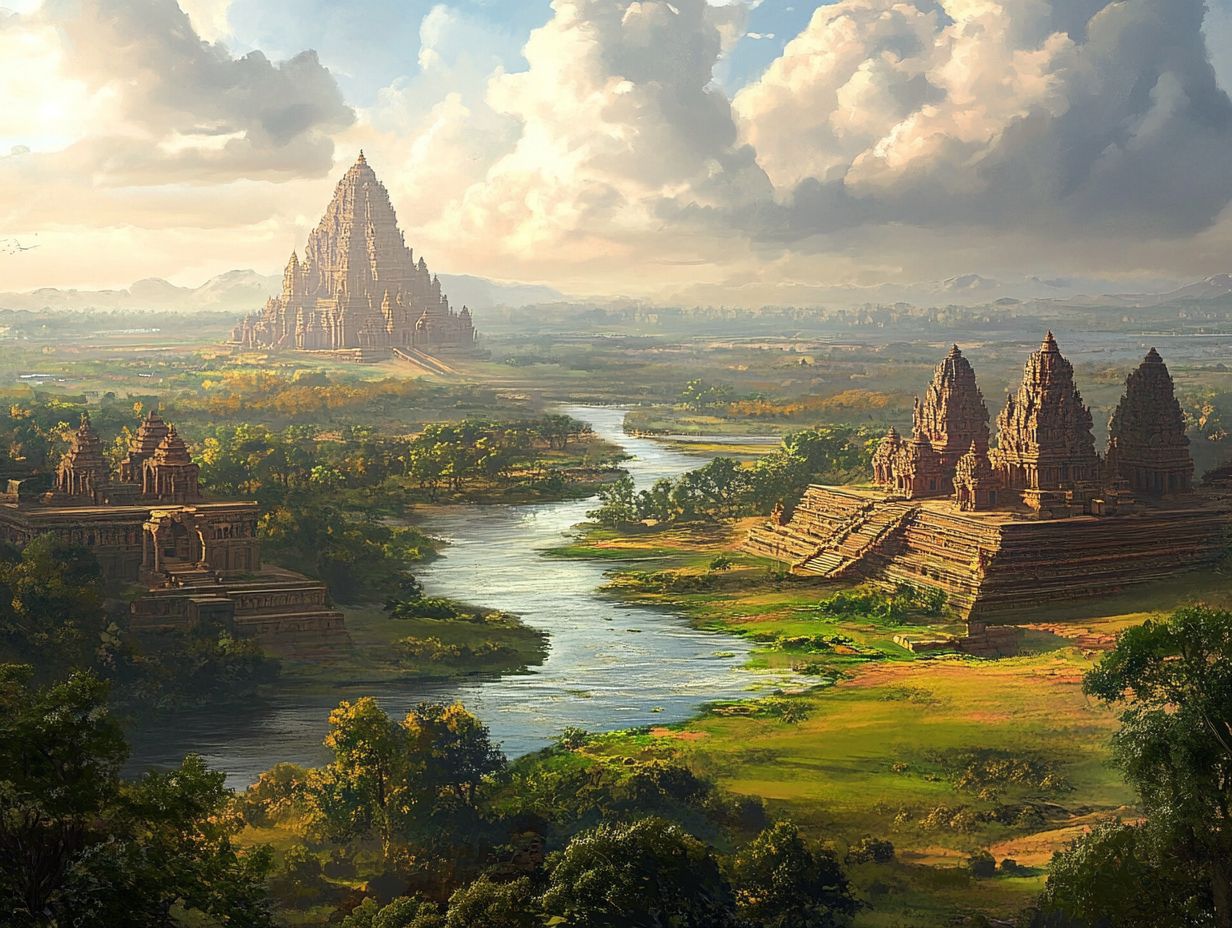The Roots of Hinduism Are Found in Which River Valley?
Hinduism, regarded as one of the world’s oldest religions, presents a rich tapestry of beliefs, practices, and cultural significance. Originating in the ancient Indus Valley, an ancient civilization in the river valley regions of Punjab, this faith has undergone profound evolution over millennia, profoundly shaping the lives of millions.
This article delves into the foundational aspects of Hinduism, examining its major beliefs and key scriptures, along with the intricate concepts of dharma and karma. It further reveals how historical events, such as the influence of the Indus River and the Vedic culture, have contributed to the religion’s development, while also addressing the modern challenges that the faith encounters today.
Readers are invited to embark on a captivating journey through the remarkable world of Hinduism, discovering its enduring impact on society and the human experience.
What is Hinduism?

Hinduism stands as one of the oldest religions in the world, distinguished by an extraordinary spectrum of beliefs, practices, rituals, and spiritual pathways that collectively weave a rich tapestry of cultural heritage and philosophical exploration.
Originating from the river civilizations of ancient India, particularly along the revered banks of sacred rivers such as the Ganges and Sarasvati, Hinduism embodies a myriad of rituals, social structures, and spiritual doctrines that have matured over countless millennia. The religion’s cultural heritage is deeply interwoven with the geography of these ancient river systems.
This evolution has inspired profound reflections on ethics, cosmology, and the very nature of the divine.
Where did Hinduism originate?
Hinduism finds its roots in the fertile basin of the Indus Valley Civilization, one of the earliest urban cultures to emerge in ancient India, flourishing around 2500 BCE. Archaeological discoveries from prominent sites like Harappa and Mohenjo-Daro offer invaluable insights into the practices of these early settlers, hinting at the cultural traditions and ancient texts that would eventually give rise to the intricate religious system recognized today as Hinduism.
What are the major beliefs and practices of Hinduism?
The core beliefs and practices of Hinduism present a nuanced comprehension of existence, articulated through essential concepts such as karma, dharma, and moksha. This tradition is steeped in a rich tapestry of polytheism and spirituality, venerating a diverse pantheon of deities and sacred rituals. Notable scriptures like the Rigveda and the Upanishads illuminate these profound beliefs.
At the heart of these teachings lies the profound understanding that individual actions (karma) shape future experiences, while the commitment to righteousness (dharma) paves the way toward spiritual liberation (moksha) from the perpetual cycle of rebirth. Additionally, practices like yoga and meditation are integral to achieving spiritual enlightenment and transcendence.
What is the concept of dharma in Hinduism?
In Hinduism, the concept of dharma embodies the ethical duties and moral responsibilities that guide individuals in both their personal lives and social interactions. This guiding principle shapes their actions in accordance with cosmic law and societal roles. Dharma, as a fundamental tenet, varies according to factors such as age, caste, and life stage, playing a vital role in sustaining societal harmony and fostering spiritual development. Teachings from epics like the Mahabharata and Ramayana further elaborate on the principles of dharma.
This intricate framework encourages individuals to cultivate a harmonious existence with their environment and fellow beings, placing a greater emphasis on responsibilities than on personal desires. For example, a student s dharma may center around the pursuit of knowledge and the respect afforded to teachers, while a householder’s obligations might be concentrated on caring for their family and contributing to the welfare of the community.
Such expressions of dharma manifest daily through acts of service, kindness, and respect within families and neighborhoods, vividly illustrating its profound influence. Teachings from revered texts, such as the Bhagavad Gita, underscore the importance of aligning personal conduct with universal principles, fostering spiritual growth that transcends individual existence to enrich the broader community.
What are the main Hindu gods and goddesses?
The pantheon of Hinduism is a rich and varied tapestry, encompassing a multitude of gods and goddesses, each embodying distinct aspects of life and the universe within a polytheistic framework. Major deities such as Brahman, Vishnu, Shiva, and Devi manifest a range of divine attributes and are venerated through an array of rituals and festivals in temples and sacred sites throughout India. This diversity in divine representation underlines the cosmogony and cosmology inherent in Hindu thought.
The significance of these deities extends far beyond mere symbolism; they act as essential focal points for spiritual connection and community bonding. For example, Vishnu, often revered as the preserver, embodies the concept of cosmic order, while Shiva, known as the destroyer, represents transformation and regeneration.
Worship practices are impressively diverse, ranging from elaborate temple ceremonies to more straightforward household rituals, reflecting the incredible richness within Hinduism. Festivals dedicated to these deities, such as Diwali and Navaratri, not only cultivate community spirit but also reinforce cultural values and traditions, illustrating how these divine figures are integral to both individual spirituality and collective identity. The celebration of these festivals also highlights the cultural diffusion and synthesis prevalent in Hindu practices.
What are the key Hindu scriptures?
Hinduism encompasses a remarkable collection of scriptures that serve as the foundation of its spiritual heritage, with the Vedas standing as the most esteemed ancient texts. These revered writings encapsulate a profound reservoir of knowledge pertaining to rituals, philosophy, and ethics. Along with the Vedas, other significant scriptures such as the Upanishads, the Bhagavad Gita, and the Puranas furnish essential insights into the religious practices and beliefs that characterize Hinduism. The ancient texts serve as a guide for spiritual practices and ethical living.
An exploration of the historical context surrounding these texts reveals their profound influence on the evolution of Hindu thought. Each scripture addresses distinct facets of existence, ethics, and the divine, shaping the rituals that remain central to Hindu worship today. The Upanishads delve into the nature of reality and consciousness, while the Bhagavad Gita provides guidance on duty and righteousness amid life’s complexities. The Puranas offer narratives that intertwine the legends of gods and deities with moral lessons.
In contemporary society, these scriptures are far from mere relics; they continue to be interpreted through various perspectives, significantly impacting personal spirituality and communal practices alike. Consequently, the vibrant tapestry of Hindu cultural heritage remains dynamic, intricately interwoven by these timeless teachings that resonate deeply with spiritual seekers across the globe. Modern interpretations often emphasize the philosophical dimensions and ethical teachings found within these sacred scriptures.
What are the roots of Hinduism?

The origins of Hinduism are intricately linked to the ancient Indus Valley Civilization, where early inhabitants forged a sophisticated society along the banks of sacred rivers. These settlers engaged in various practices that would gradually evolve into the rich tapestry of beliefs now known as Hinduism. The historical significance of this region is underscored by its role in the cultural diffusion and synthesis of spiritual practices.
This complex interplay of geography, social dynamics, and cultural exchange established a foundation for a diverse array of spiritual beliefs and rituals that continue to influence Hindu practices in contemporary society. The evolution of religion in this region showcases its adaptability and resilience through time.
What is the Indus Valley Civilization?
The Indus Valley Civilization, which thrived around 2500 BCE, stands as one of the earliest urban civilizations, distinguished by extraordinary achievements in architecture, engineering, and social organization, as revealed by extensive archaeological discoveries at sites such as Harappa and Mohenjo-Daro. This ancient civilization established a foundation for cultural practices and urban living that would profoundly influence the spiritual and social landscape of future Indian society. The civilization’s early advancements in agriculture and trade contributed to its sustained growth and interaction with neighboring regions.
Its meticulously planned cities showcased advanced drainage systems, standardized fired bricks, and granaries, demonstrating a sophisticated grasp of urban planning and public health. The societal structure appears to have been relatively egalitarian, with evidence indicating a bureaucratic system overseeing trade and the distribution of resources. This early urban planning influenced subsequent civilizations in the Indian subcontinent.
Noteworthy archaeological finds, including seals adorned with intricate carvings, suggest the presence of early forms of writing and possibly religious beliefs, hinting at connections to the nascent strands of Hinduism. These discoveries enrich our understanding of how the values and practices of this civilization may have laid the groundwork for the cultures that followed in the Indian subcontinent. The Indo-Aryans, who later migrated to the region, further contributed to the cultural roots and religious practices of Hinduism.
What role did the Indus River play in the development of Hinduism?
The Indus River has been instrumental in shaping the development of Hinduism, serving as an essential lifeline for the Indus Valley Civilization while nurturing a cultural identity that intricately weaves spirituality with the natural landscape. This revered river, alongside others such as the Ganges, Yamuna, and Sarasvati, embodies the profound interconnectedness of water and spirituality within Hindu traditions, significantly influencing rituals and collective beliefs. The sacred geography of these historical rivers continues to hold religious significance in modern Hindu practices.
For the early settlers of the Indus Valley, the river was more than a mere source of sustenance; it was a sacred entity that profoundly shaped their worldview. Its banks were the backdrop for numerous community gatherings, where rituals were conducted to honor the water deities believed to preside over life and prosperity. The river’s ebb and flow mirrored the cyclical nature of existence, reinforcing the bond between the land and the divine.
Consequently, the Indus River emerged as a vital thread in the intricate tapestry of cultural identity and spirituality, fostering a deep spiritual relationship that resonated through generations. This relationship reflects the broader significance of sacred rivers within Hinduism, symbolizing purity and the essence of life.
How did the Vedic period shape Hinduism?
The Vedic period, emerging after the decline of the Indus Valley Civilization, signified a pivotal transformation in Hinduism, heralding the introduction of a sophisticated system of rituals, hymns, and philosophical exploration found within the ancient texts of the Vedas. This era established the groundwork for numerous fundamental spiritual beliefs and practices that continue to influence Hindu thought today, highlighting the significance of ritual purity, meditation, and the pursuit of enlightenment.
During this transformative epoch, a myriad of deities were honored through intricate sacrifices and prayers, which not only cultivated a profound connection between the divine and the devotee but also cemented the priestly class’s role within society. This period also saw the rise of Brahmanism, which played a crucial role in shaping religious practices and social structure.
Key philosophical texts, including the Rigveda, arose, diving into deep inquiries regarding the nature of existence and the self, mirroring humanity’s intrinsic quest for understanding and connection to the cosmos. As these spiritual ideologies proliferated and evolved, they left an indelible mark on successive generations, weaving a rich tapestry of rituals and concepts that adapted to cultural shifts over the centuries, ultimately shaping the diverse landscape of contemporary Hindu practices.
What are the main principles of Hinduism?
The foundational principles of Hinduism center on the deeply interwoven concepts of karma, dharma, and moksha, which collectively shape the ethical values and spiritual beliefs guiding practitioners along their spiritual journeys.
These principles highlight the importance of moral actions and their repercussions, underscore the necessity of fulfilling one s duties, and articulate the ultimate aspiration of attaining liberation (moksha) from the cycle of birth and rebirth.
In this intricate tapestry of beliefs, each element plays a crucial role in the spiritual development of individuals navigating their journeys.
What is the concept of karma in Hinduism?
In Hinduism, the concept of karma embodies the intricate law of cause and effect, where an individual’s moral actions delineate their future experiences, profoundly influencing their spiritual journey and the cycle of rebirth (reincarnation). A deep understanding of karma prompts practitioners to engage in actions with heightened awareness and intention, acknowledging that their deeds carry enduring consequences in this life and the next.
This profound principle underscores that every decision, whether seemingly trivial or of great significance, contributes to a person’s karmic footprint. For instance, when an individual opts to assist others selflessly or engages in acts of compassion, they not only cultivate positive karma for themselves but also inspire those around them to embrace similar behaviors, engendering a ripple effect of goodness throughout their community. Such actions are deeply rooted in the teachings found in sacred scriptures and religious texts.
Spiritual teachings, such as those articulated in the Bhagavad Gita, further reinforce the necessity of right action as a pathway to spiritual enlightenment. By recognizing their intrinsic power to shape their destinies, individuals can harmonize their daily conduct with the ethical standards enshrined in Hindu philosophy, thereby enriching both their moral framework and their overall existence.
How does the caste system play a role in Hinduism?

The caste system represents a complex social hierarchy that has profoundly influenced Hinduism, shaping individual identities and community dynamics throughout history. Rooted in ancient texts and cultural practices, this system classifies individuals into distinct groups, each defined by its own set of duties and ethical values (dharma), ultimately affecting various life aspects, including marriage, occupation, and social interactions.
This hierarchy has not merely influenced personal identities; it has also significantly contributed to the broader social framework within Indian society. As different castes emerged, the implications of this classification extended to opportunities for advancement and access to resources, often erecting barriers that marginalized lower castes.
In contemporary society, individuals continue to grapple with the remnants of this system, where caste-based discrimination remains a formidable challenge. In recent years, concerted efforts have been made to address these disparities, fostering discussions that question traditional viewpoints, promote social equity, and highlight the necessity for inclusive reforms. Such initiatives aim to reshape societal perspectives and transform individual experiences related to caste.
What is the ultimate goal of Hinduism?
The ultimate aspiration of Hinduism is moksha, a state that embodies spiritual liberation from the perpetual cycle of birth and rebirth (reincarnation), allowing individuals to merge with the divine essence. This enlightened state is realized through unwavering spiritual practice, ethical living, and the relentless pursuit of knowledge, culminating in a profound understanding of one’s true nature.
To achieve this elevated spiritual condition, several paths are typically recommended, including meditation, yoga, and adherence to dharma. Meditation emerges as a potent instrument for introspection and self-realization, enabling practitioners to still their minds and enhance their connection with the universe. Likewise, the practice of yoga unifies physical, mental, and spiritual disciplines, presenting a comprehensive approach to achieving self-awareness and harmony.
Adhering to dharma, or righteous living, further steers individuals on their spiritual journey, ensuring that their actions resonate with ethical principles and contribute to the greater good. Together, these practices encapsulate Hindu beliefs that highlight the significance of inner peace, ethical responsibility, and self-discovery on the path to moksha. These spiritual practices have evolved through centuries of cultural exchange and religious synthesis.
How has Hinduism evolved over time?
The evolution of Hinduism throughout history has been intricately shaped by cultural shifts, significant historical events, and the profound influence of various spiritual leaders. This has culminated in a dynamic religious framework that not only adapts to modern society but also preserves its fundamental values. The religion’s development is also marked by the integration of monism and polytheistic traditions, which showcase its theological diversity.
Such continuous development highlights the religion’s remarkable capacity to integrate a wide array of practices and beliefs, thereby creating a rich tapestry of spirituality that resonates deeply with contemporary practitioners.
What is the influence of Hinduism on modern Indian society?
Hinduism exerts a profound influence on modern Indian society, intricately shaping cultural practices, social values, and community traditions that unite individuals in shared spiritual experiences. From vibrant festivals to cherished family rituals, the principles of Hinduism permeate daily life, guiding ethical conduct and fostering a sense of belonging among diverse communities.
The celebration of Diwali, for example, not only symbolizes the victory of light over darkness but also exemplifies familial unity as loved ones come together to engage in prayers, feasts, and communal festivities. Likewise, observances such as Holi promote communal harmony, transcending the boundaries of caste and creed. Family traditions, including the reverence for elders and the practice of joint family living, reflect the teachings of dharma, illustrating how Hindu values shape interpersonal relationships.
These facets of Hinduism not only enrich cultural identity but also play a significant role in societal cohesion, weaving a rich tapestry that intertwines individual practices with a collective consciousness. The influence of Hinduism is evident in various cultural practices, including festivals, rituals, and the celebration of epics such as the Mahabharata and Ramayana.
How has Hinduism spread to other parts of the world?
The global proliferation of Hinduism is intricately linked to historical migrations, the establishment of trade routes, and the expansive Indian diaspora. This dynamic movement has facilitated a rich cultural diffusion, introducing its profound spiritual traditions to diverse regions around the world. As various communities embrace Hindu beliefs and practices, they contribute to a vibrant tapestry of religious plurality, enhancing global understandings of spirituality and cultural heritage. This cultural exchange has led to the establishment of temples and sacred sites in many countries, fostering a shared sense of religious significance.
The migration of peoples, particularly during colonial periods and more recently in the context of globalization, has allowed Hinduism to penetrate a wide array of communities. In nations such as the United States, Canada, the United Kingdom, and Australia, temples and cultural centers serve as vital hubs for connection, where rituals and festivals are celebrated with enthusiasm and reverence. This global presence highlights the enduring cultural heritage and religious significance of Hinduism.
Moreover, the interplay of technology and cultural diffusion plays a significant role in this cultural exchange; social media platforms and online forums have enabled the widespread dissemination of teachings and practices, fostering a sense of belonging among Hindus in the diaspora. As these communities integrate into new social landscapes, they often adapt their traditions, resulting in a unique fusion that honors their cultural heritage while embracing the local cultures around them.
What are the current challenges facing Hinduism?
Hinduism encounters a myriad of challenges in today’s world, grappling with issues related to cultural identity, religious tolerance, and the pressures of globalization that jeopardize traditional practices and beliefs. This necessity for adaptation, all while preserving core values, has ignited spirited debates within the community regarding the relevance of ancient teachings and ancient texts in the face of a rapidly evolving societal landscape.
Such struggles are particularly pronounced as individuals strive to navigate their spiritual convictions amid the growing pressures to conform to contemporary norms. Many practitioners find themselves in the position of questioning how to uphold rituals and customs and spiritual practices while actively engaging with a globalized society that frequently elevates individualism above communal ties.
The rise of political movements has further intensified tensions surrounding religious identity, with certain factions attempting to redefine Hinduism in potentially exclusionary ways. Responses within the community are remarkably diverse; some advocate for a return to fundamental principles, while others embark on innovative interpretations designed to resonate with younger generations. This reflects a dynamic interplay between tradition and modernity, highlighting the complexity of maintaining identity in an ever-changing world.
Frequently Asked Questions

What is the significance of the river valleys in the roots of Hinduism?
The river valleys were the birthplace of Hinduism and played a major role in shaping its beliefs and practices. The geography of these regions contributed significantly to the cultural roots and historical significance of early Hindu traditions.
Which river valley is considered the cradle of Hinduism?
The Indus River Valley in ancient India is considered the cradle of Hinduism.
How is the Indus River Valley linked to the origins of Hinduism?
The Indus River Valley is believed to be the location where the Indus Valley Civilization, which predates Hinduism, existed and led to the development of Hinduism. This ancient civilization had significant cultural and spiritual practices that influenced later beliefs.
What role did the Indus River play in the development of Hinduism?
The Indus River, along with other rivers in the region, was a source of livelihood for the people living in the Indus Valley Civilization. This dependence on the river led to the worship of water and other natural elements, which became a key aspect of Hinduism. The sacred rivers like the Ganges and Yamuna hold spiritual significance in Hindu practices.
Are there any other river valleys that have influenced the roots of Hinduism?
Yes, the Saraswati River Valley is also believed to have played a significant role in the development of Hinduism, as it was mentioned in ancient Hindu texts and was also a major source of water for the people living in that region. The Saraswati, along with the Indus, forms a crucial part of the sacred geography in ancient Hindu culture.
How does the concept of river worship tie into the roots of Hinduism?
The worship of rivers, especially the Ganges, is a key aspect of Hinduism as it is believed to have purifying and healing properties. This practice has its roots in the early civilizations that existed in the river valleys of ancient India, which attributed spiritual and cultural significance to these historical rivers.
